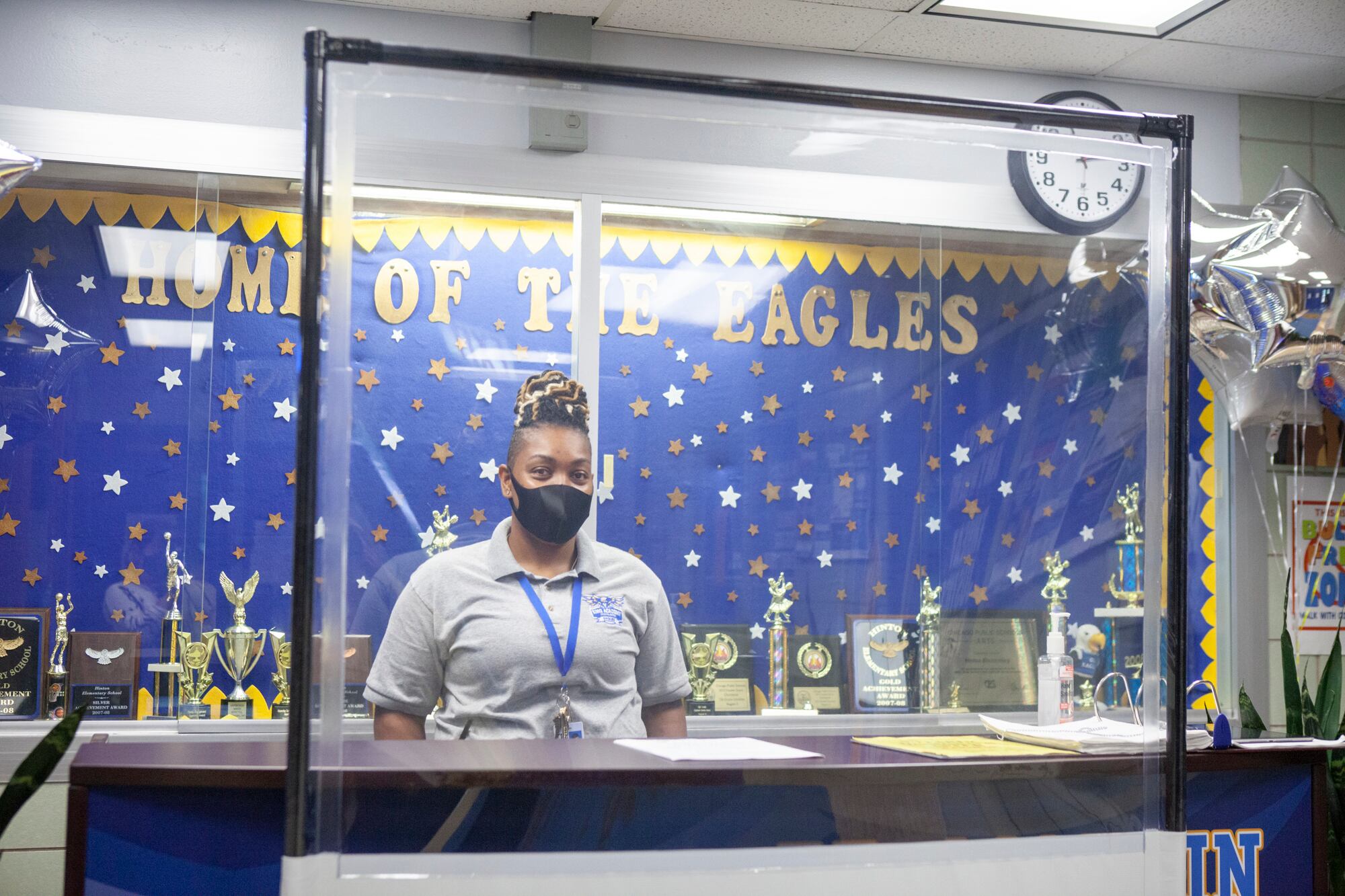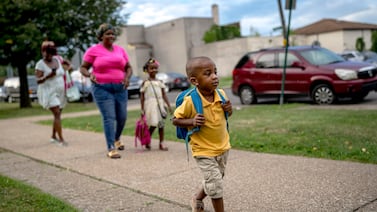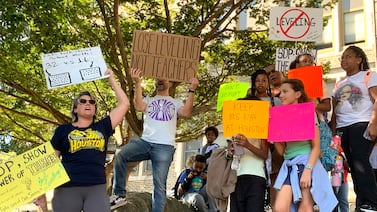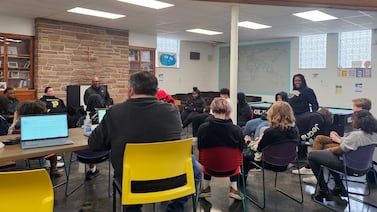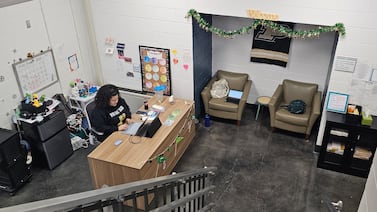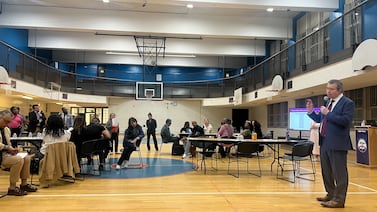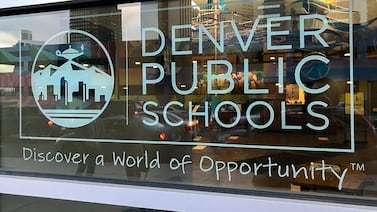When occupational therapist Nakii Wilson returns to in-person school in early 2021, she says it will be like the first day of school all over again for her and her students.
“It’s literally going to be Day 1 for these friends to come into the building and learn these new routines,” said Wilson, who works with preschool students at a school on the South Side and calls them her “friends.”
She’s worried about how her young students will socially distance and whether she can teach them how to hold a pencil without getting too physically close. She’s not alone.
Wilson is among the thousands of Chicago teachers, counselors, speech pathologists, and social workers who work with students who have disabilities. Children with disabilities have been the least served by remote learning, and district officials have said offering optional in-person school for these students starting Jan. 11 is an issue of equity.
As in other cities that have called special education programs back first, Chicago clinicians and educators are the vanguard of a reopening plan that requires them to report back on Jan. 4. Their jobs require specialization and close contact that doesn’t fit neatly into reopening FAQs that spell out six-feet distances and hours of mask-wearing, and educators feel unprepared and worried about returning.
District guidance so far appears to focus on extra protective equipment for teachers and suggestions on how to re-engage students in person and teach them social distancing rules. But educators say the plan lacks critical details about behavior, particularly on how to handle students who may not want to stay in their seats or wear masks.
How do you assist someone with using the bathroom from six feet away? How do you refashion a lesson on sharing that relies on physical contact and passing materials back and forth?
“If you work with kids with sensory issues, what will you do if they take their masks off? I have deep concerns about the lack of guidance for students with behavioral concerns,” said Erin Young, a Chicago special education cluster teacher for kindergarten to second grade.
Chicago’s reopening plan has a heavy lift. It must not only address the countless situations that could arise in classrooms with vulnerable students, but also meet the legal disability rights promised to those students. Some of those supports are in conflict with by-the-letter COVID-19 health and safety rules, say teachers.
Teachers and support staff say they’ve called the central office, peppered their network chiefs and principals with questions, and handed over lists of queries to union representatives.
Unanswered questions
So far, about 6,470 pre-K and cluster program students are expected to report back in January, though actual numbers will likely be lower since parents can opt back into remote learning at any time.
Educators want clearer guidance on several issues, including how to handle behavioral issues while social distancing and how to accommodate students who struggle to wear masks because of sensory issues. They also want to know how and where clinicians and other support staff will provide specialized services. Many providers rotate among schools, and at some schools they work out of small, often windowless closets.
“I feel like there are a lot of unanswered questions — I haven’t received any guidance from the department,” said Emily Penn, a school social worker. She’s also worried about her students’ social and emotional health when they need comforting.
“How can I teach them to share when we can’t touch?” she wonders.
Barbara Cohen, special education legal advocate at Legal Council for Health Justice, says she is most concerned that she has yet to see a detailed plan addressing staff who travel to multiple buildings or serve students in multiple pods.
“The lack of communication has left parents, educators and advocates suspicious,” she said.
Still, Cohen said she supports the reopening, with the caveat that medically fragile students shouldn’t return to schools. It concerns her that data so far shows that low-income students, students of color, and students with disabilities have been less engaged in remote learning.
Fewer students and new skills
For high school cluster teacher Tim Daly, the January return won’t look like a typical first day of school.
For one thing, Daily will be teaching a pod of fewer than seven students, about half the number usually in his classroom, in an effort to minimize the risk of COVID-19.
There will also be extra technology to help ease students out of remote learning and help educators transition to simultaneous teaching of remote and in-person students. Extra cameras will be trained on the paraprofessionals moving around the room as the classroom activities are broadcast to students at home.
While some students struggled with remote learning, Daly says many of his older students, whose ages range from 16 to 22, have excelled in it, so he will keep some online lessons at first.
“Continuity and consistency is key” for older students in cluster programs learning life skills, said Daly. “Working through the screens is the sensory input they have grown accustomed to, so we are planning to slowly develop off-camera activities so the kiddos can comfortably move” to in-person work.
Some parents have concerns about the transition from online to in person. Cindy Ok, whose daughter is set to graduate this spring from Vaughn Occupational High School, a speciality school for students with complex disabilities, said she is worried the time it will take to adapt to a new set of classroom rules will cut into learning. “It will be very challenging in the beginning,” said Ok, who opted to keep her daughter learning from home.
A new normal
Counselors, speech pathologists, and social workers also face big changes when they return to schools. They wonder whether the district’s ventilation assessments included the storage rooms and closets that often double as their offices. Their caseloads often include students from multiple schools, and they are worried that in an effort to reduce exposure, they’ll be reassigned to a new group of students.
That means starting the year rebuilding relationships, says Penn, who splits her caseload between two Chicago schools. “What sense of normalcy and consistency will the students have in regards to their teachers and related service providers?” she asks.
A document on reopening from the Office of Diverse Learner Supports and Services suggests educators start building relationships with their students before school starts by sending them two photos: one of the educator smiling, without a mask, and one with a mask. The document also suggests teachers put together a video tour of the classroom and wear a mask in the video to get students used to seeing educators masked.
When school begins, the district is encouraging teachers to wear masks with clear sections in the middle so students can see their mouths, use visual guidelines such as tape on the floor or hula hoops to mark distances, and post visual signs describing hand-washing and distancing best practices.
The district recommends that educators hew to current guidance for behavioral issues. “Cluster program educators are highly trained and prepared to deal with a variety of behavioral scenarios during instruction and the response to these types of behaviors largely does not deviate from prior best practices, other than making an effort to continue to maintain a safe distance whenever possible,” spokesperson James Gherardi said in response to questions from Chalkbeat.
Educators say those guidelines don’t do enough to cover the range of complicated and nuanced situations that they faced every day in classrooms even before COVID-19. They say it may be impossible to remain socially distant and juggle students running out of the room, crying in class, or repeatedly removing their masks.
“We don’t really have guidance for what you do if you have a kid who is biting or spitting,” said Young. “Safety Care” — a training program for how to handle behavior challenges with vulnerable populations — “is the approved program for de-escalation, but none of the methods you use with Safety Care can be done from a socially distanced place.”
Clinicians and social workers also say they have unanswered questions about scheduling for support staff. How should they juggle pods within the same school or between several?
“They’re building the plane while it’s flying,” said Theresa Toro, a school social worker who’s worried about returning to her windowless office at Richardson Middle School and has applied for health-related accommodations. Chicago Public Schools has said teachers may apply for health-related accommodations or take leave, but those who don’t qualify are expected to return to work. “Central office has nothing for us. That has been the biggest frustration, and the biggest fear.”
The district is hiring 2,000 additional staff for when schools reopen, in part to step in if educators get sick, need additional support, or don’t return. Some of them will be paid $15 an hour to supervise students, while others, called “cadre substitutes,” could step in as substitutes or teaching supports.
But educators say that support staff will face some of the same safety and logistical challenges working with students in cluster programs.
With only weeks to go until students return to buildings, Nakii Wilson, the South Side clinician, said she isn’t waiting on Chicago Public Schools to provide all of the answers she’s seeking.
She has purchased her own stock of additional face masks and shields. With hundreds of other educators, Wilson will walk into school buildings for the first time this January with sanitizer, extra masks, and a social distancing plan in hand.


